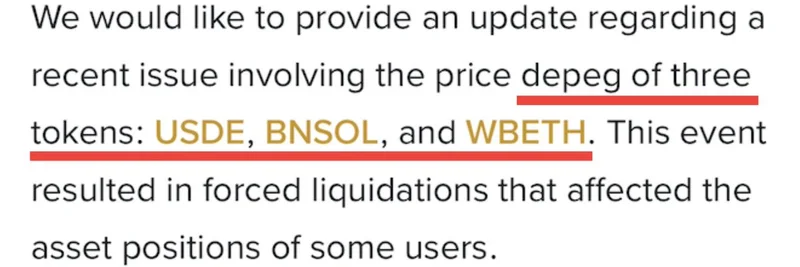If you've been trading crypto, especially on big exchanges like Binance, you know how quickly things can go sideways. Just recently, on October 11, 2025, Binance hit a rough patch with some serious price depegs affecting tokens like USDE, BNSOL, and WBETH. For those not in the loop, a "depeg" happens when a stablecoin or pegged asset loses its intended value tie—think USDE, which is supposed to stick close to $1, suddenly dropping to around $0.66. This glitch led to forced liquidations, wiping out positions for some users and sparking widespread frustration.
Binance quickly issued an update acknowledging the issue, as seen in their official statement here. They explained that the depeg caused unintended liquidations, and they're working on compensation for affected traders. Reports from sources like Coinpedia highlighted the severity, with USDE plunging to $0.6567 and similar drops for BNSOL and WBETH, contributing to massive market-wide liquidations—some estimates even point to billions in losses across the crypto space.
But here's where it gets interesting for DeFi enthusiasts, especially those in the Solana ecosystem. While centralized exchanges like Binance rely on their internal price feeds, which can sometimes glitch or lag, on-chain protocols often use decentralized oracles that pull data directly from the blockchain. Take Loopscale, a modular lending protocol built on Solana. It's designed for overcollateralized borrowing and lending using an order book model, which means it matches lenders and borrowers efficiently without the pooling risks you see in other platforms.
In the midst of this Binance turmoil, users like Fabiano Solana shared their experiences on X (formerly Twitter). Fabiano had several leveraged positions—or "loops"—open on Loopscale, involving assets from protocols like Huma, Ratex, and OnRe. Despite the chaos on Binance, he reported zero depegs and zero liquidations. Why? Loopscale's architecture leverages Solana's high-speed, on-chain data, making it more resilient to off-chain price feed issues. As Fabiano put it, "good tek I guess"—tech being short for technology, highlighting the robustness of these DeFi tools.
For context, Loopscale isn't your average lending app. According to their docs at loopscale.com, it supports a wide range of assets, including those tied to yield-bearing strategies. This is huge for meme token traders, who often loop positions to amplify gains on volatile assets. Meme tokens on Solana, like those pumped on platforms such as Pump.fun, can swing wildly, but using a protocol like Loopscale means you're less exposed to centralized failures. Remember, Solana's DeFi TVL has exploded past $4 billion in 2025, with players like Kamino leading the charge, but Loopscale's order book approach offers fixed rates and better risk isolation.
Replies to Fabiano's post echoed this sentiment. Users mentioned holding $xSOL on Kamino without issues, liquidity providing on Meteora raking in fees during the volatility, and overall praise for on-chain stability. It's a reminder that while centralized exchanges handle massive volume, DeFi on chains like Solana provides an alternative that's often more transparent and resistant to single points of failure.
Of course, no protocol is bulletproof—Loopscale itself faced a hack back in April 2025, losing about $5.8 million due to a pricing exploit, as detailed by security firms like Halborn. But they've bounced back, implementing stronger safeguards, and events like this Binance depeg show why diversifying into DeFi can be a smart move.
If you're into meme tokens or just looking to level up your blockchain game, keep an eye on protocols like Loopscale. They not only help you borrow and lend efficiently but also shield you from the kind of volatility that tanks centralized positions. Stay tuned to Meme Insider for more updates on how these events impact the meme economy and tips to navigate the wild world of crypto. What's your take—stick with CEXes or go full DeFi?


